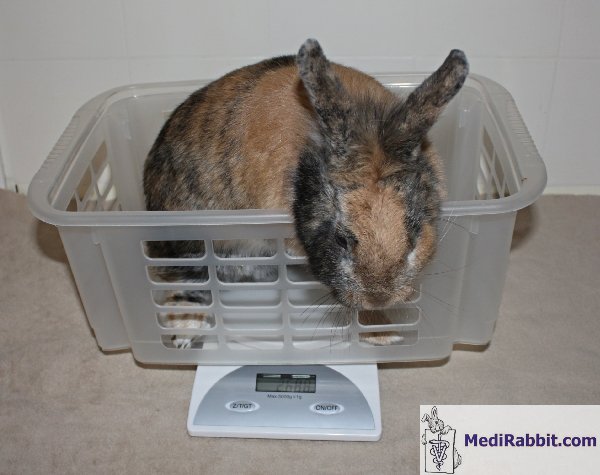Recommendation
to ALL rabbit owners:
Monitoring the
weight of a rabbit
Dr. Amir Maurer
Companion and Exotic Animal Veterinary Center,
Holon, Israel
|
MediRabbit.com is funded solely by the
generosity of donors. Every donation, no matter what
the size, is appreciated and will aid in the continuing research of medical
care and health of rabbits all over the world. Thank you |
|
Rabbits,
rodents and birds can suffer from a health problem over a prolonged period of
time, without showing outward signs, without change of appetite. The disease
- especially dental disease - will not stop progressing. The result can be
devastating to the animal, with secondary effects on its health. Secondary effects
dental problems 1. Spurs, overgrown molars, deformed teeth can cause: -
Damage the gums and tongue, and possible secondary bacterial or yeast
infections; -
Ptyalism (hypersalivation, slobbering) and secondary inflammation of
the skn (dermatitis) and alopecia. 2. Elongation of the roots of incisors or cheek teeth
can cause various problems: -
Compression or blockage of the nasolachrymal duct cause a runny eye or
dacryocystitis; -
Infection of the dental root, with development of a root abscess or a
retrobulbar infection; -
Infection of the root and deformation of the bone due to dissolution
of bone (osteolysis) or osteomyelitis; -
Dysplastic changes, e.g., pseudo-odontoma, that lead to compression of
the nasal cavity, difficult breathing, sneezing or “reversed” sneezing; -
Discomfort and/or pain caused by the dental problem leads to a
decreases appetite; -
Secondary renal failure, due to anorexia, hepatic lipidosis,
septicemia. 3. Behavioral and diet changes due to discomfort or pain,
such as a sudden aggressiveness or shyness, nibbling of furniture, changes in
food habits, licking a long ignored salt block. How can this be avoided To avoid
these tragic situations, it is worth buying a digital scale to weigh the
animal at least monthly. The average of three measurements should be taken
and noted- this is the stable weigh of a rabbit. When there is
a loss of 10% of stable weight - call for a vet exam. This simple
method is a great help to veterinarians as it allows to "catch"
many diseases as they begin, especially dental disease. Material needed
Tarring
Weighing the
rabbit... Since rabbits often move in the
box, which affects the weight shown on the digital scale, it is best to take
a few measurement and calculate the average:
Thanks to
Yara and Kaspi for their cooperation. |
e-mail: info@medirabbit.com








